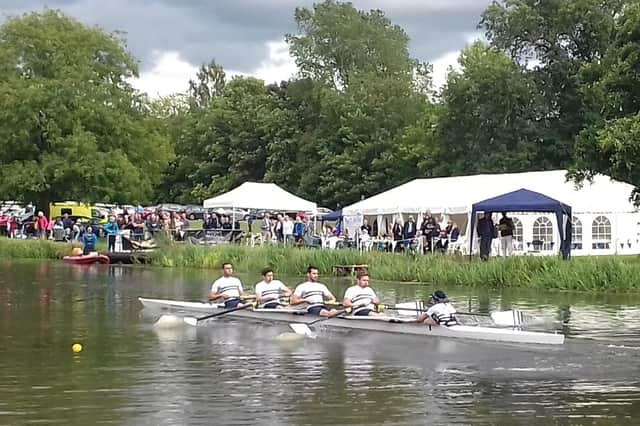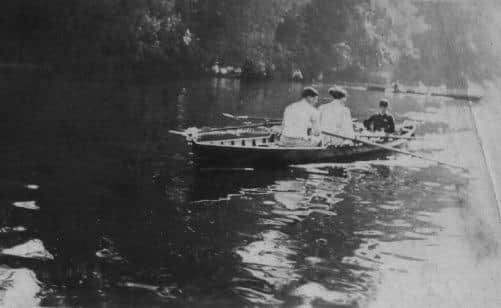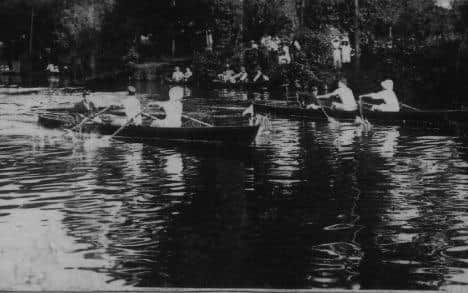Four seasons on Warwick's River Avon: A view of the historic river in the summer


Summertime, and the living should be easy for rowers, as water temperatures rise, river flows drop, and conditions improve.
It certainly appears to be easier for much river life, with the Upper Avon’s contribution to the ecology of the whole of the River Avon river system documented elsewhere. Its riffles and pools are an important part of the fish stock’s breeding cycle. It supports many different species of bird including ducks, herons, kingfishers and others.
Advertisement
Hide AdAdvertisement
Hide AdEvery year, the river at Warwick also supports a family of swans with – this year (at the time of writing) - five – originally seven - cygnets. Nature is cruel but this is good news when often only a single cygnet survives to adulthood – and especially so when avian flu has wrought havoc with swan populations on other stretches of the river.


But rowing isn’t easy, for several reasons.
Rowing is arguably the main spectator sport on the Avon and dates back to 1861 when Warwick Boat Club was founded. It is the oldest rowing club in the Midlands this side of the River Severn, but despite its illustrious credentials the Avon at Warwick is very much a shared asset with summer making the river more attractive for many other users.
Interesting fact: In the days when WBC used to rent its current site from the Earls of Warwick, before buying the land in 1959, the lease agreement forbade Boat Club members from swimming in the river.
Anglers, canoeists, Sea Scouts, dragon boaters, paddle boarders, wild swimmers, and of course, boat hirers on unicorn, dragon, pink flamingo or other fantasy-design pedalos – all make an appearance as the days lengthen and the sun shines more often.


Advertisement
Hide AdAdvertisement
Hide AdWhich makes life less easy for the rowing fraternity, whose general intention is to cover the available distances as quickly as possible.
It is a sport built on fast, fragile boats designed for speed. Even single sculls are now worth well over £5,000 each so any accidents are inevitably expensive. But they believe it’s a price worth paying though to see, or better still experience, these craft gliding majestically along the river at any speed.
Warwick is blessed with having such a club, which has a fine tradition of nurturing junior and senior athletes since rowing restarted at the club in 1987 Warwick Boat Club rowers have a self-imposed limit of a maximum of eight boats allowed onto the water at any one time, for safety reasons. And there are strict club rules about river circulation patterns, timings when boating is permitted, where boats are permitted to turn, and a whole host of other regulations which have evolved over many years of river use, to deliver safe sports activity to the rowers.
Famously, crew rowing relies on teams honed to perfection, which demands hours of practice, yet the rowers tailor their activities to fit in with other users, attempting to fit most training outings into either early morning or late afternoon and evening slots. This avoids the trading period for the boat hire business in St Nicholas Park whose customers understandably wish to enjoy the river from late morning until early evening.
Advertisement
Hide AdAdvertisement
Hide AdEqually understandably, most are generally unaware of the ‘rules of the river’ (for those who don’t know, it’s the opposite of our road usage rules – we stay on the right in our direction of travel).
Most paddle boarders understand the need to respect the navigation rules of the river and because they are a lot slower than racing boats, they are relatively easy to overtake.
Canoeists tend to have a coach supervising the group outings they organise, who obviously respect and enforce the navigation rules, and so don’t cause too much disruption for the rowers.
Wild swimmers can be very slow moving in comparison to a rowing boat, but most stay on the right side of the river. The biggest issue with swimmers is that – contrary to their sport’s guidance rules - not all wear brightly coloured swimming caps, or carry a Hi-Viz buoyancy float, which can make them very difficult to spot, especially in poor light conditions. This puts a safety burden of responsibility on the rowers to keep an extremely good look-out to avoid any collisions - very hard when you have no cox and are facing the wrong way!
Advertisement
Hide AdAdvertisement
Hide AdSo, competition for space on the river at the very time of the year when rowers are seeking to hone their race fitness and develop boat speed is a big hurdle for this high-achieving group of athletes.
The rowers just get on with it as best they can. Compromising, adjusting and adapting to fit with all other users. Because they love their sport…
Many of WBC’s athletes aim for the highest standard of competition they can, with national and regional regattas the target. Several club members have represented WBC at World, European, Commonwealth and national events, winning a number of medals - including the most lustrous.
A number of crews have qualified for the prestigious Henley Royal Regatta over the years, and the Club regularly sends competitors to both the Henley Women’s and Henley Masters regattas.
Advertisement
Hide AdAdvertisement
Hide AdWarwick - one of the most landlocked clubs in the country - has even had an athlete complete the trans-Atlantic rowing race as part of the Talisker Challenge.
Undoubtedly one of the highlights of any Warwick rower’s year is the club’s own regatta, which typically takes place on the third Saturday in August. Months of planning, organising, booking marquees, catering, safety boats and a whole host of other requirements to safely run a regatta are willingly taken on by volunteer club members to ensure a memorable event for members and visitors alike.
This is the one day of the year that rowers normally have the river to themselves, allowing up to a dozen local and regional clubs to enter the Warwick Regatta, with as many as 250 athletes, and their families, converging on the town.
The regatta is also a unique town event with hundreds able to appreciate the regatta from St Nicholas Park for free, with a full range of entertaining events from top flight oarsmen to a customary unique fun finale (between crews representing the Boat Club’s tennis and squash sections) where the only requirement is for the two crews not to have rowed before! Splashing
galore…
Advertisement
Hide AdAdvertisement
Hide AdDue to the relatively short nature of its race course (500 metres from the Club grounds up to the Sailing Club compound), the Warwick regatta has developed a reputation as a good event where juniors and novices can develop a taste for competing, and for experienced rowers to enjoy a fun event in a terrific setting. No other regatta has a castle dominating its start line…
All rowing clubs in this country rely on their regattas, not only as a major source of funds for re-investment but also there is a certain ‘raison d’etre’ that all serious clubs have an event in the national rowing calendar. Without this, there is a serious long-term risk that the hard work and investment in rowing for all at Warwick may wither on the vine. The regatta lets other rowing clubs know that Warwick takes rowing seriously enough to put in the hard work required to organise a regatta.
The regatta has also provided a peg to hang other Warwick town activities on and is a major town event in August. It boosts visitors to the town, helping the various hospitality venues close to the river. Although the regatta has been a town fixture from the late 1980s (Covid aside) it remains largely unadvertised and untapped in its civic potential. But, as always, more could have been done to spread the benefits of this attraction…
BUT – perhaps the most serious threat to such activity on the river has recently emerged from a completely unforeseen angle. After two years of Covid cancellations, the town regatta faces possibly its biggest challenge…
Advertisement
Hide AdAdvertisement
Hide AdAn existential threat to the Club’s own regatta has emerged due to Warwick District Council’s decision to allow the former Sailing Club enclosure on the Myton Road side of the river to be ‘re-wilded’ despite already having a much larger area in a wild state less than 100m upstream, where the swans nest, created before rewilding became a common term.
Discussions are still on-going, with a view to agreeing how future regattas could be run, but the Boat Club has accepted that there will be no regatta for the third year in a row (sorry…).
So, the fish may be jumping, and the corn may be high, but summertime rowing on Warwick’s River Avon certainly isn’t easy.